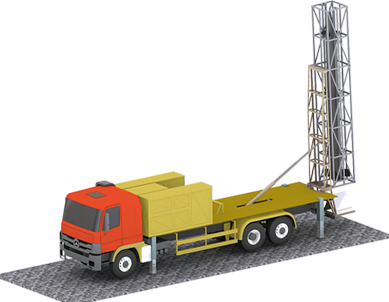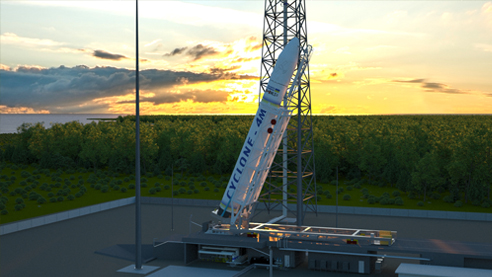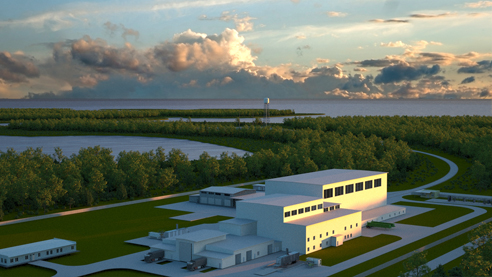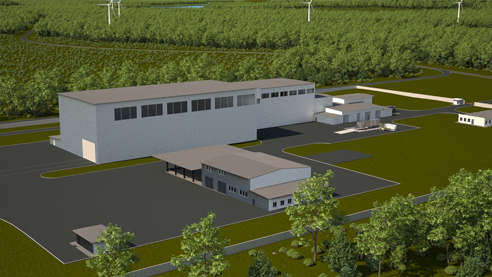Space launch systems
Space launch systems
Space launch systems
SLS BASING MODES
SLS STATIONARY BASING

SLS Stationary Basing
DESCRIPTION
BASIC SPECIFICATIONS*
| Number of launches per year | 12 |
| Launch mission duration (depending on ILV class), max, days | 25 |
| Duration of ILV prelaunch and launch operations on launch site, max, days | 3 |
| The following conditions are ensured in SC processing facility: | |
| air temperature, °С | plus 18 to plus 25 |
| relative humidity, % | up to 80 |
| environment cleanliness in facility, class | 8 ISO |
| Resistance of equipment to external effects during operations in launch area: | |
| ambient air temperature, °С | from minus 50 to plus 50 |
| maximal wind speed during ILV launch at 10 m altitude above ground surface, m/s | 15 (with gusts up to 21) |
*The data presented are for reference and may vary depending on ILV types.
SLS Sea Basing

SLS Sea Basing
DESCRIPTION
BASIC SPECIFICATIONS*
| Number of launches per year | 12 |
| Duration of launch mission without taking into account sea transit, max, days | 25 |
| Duration of prelaunch processing and launch operations at launch point, max, days | 3 |
| The following conditions are ensured in SC and PLU ATB facility: | |
| air temperature during assembling, °С | plus 18 to plus 25 |
| relative humidity, % | up to 80 |
| environment cleanliness in SC processing rooms, class: | 8 ISO |
| GSE resistance to external effects during operations in launch area: | |
| ambient air temperature, °С | plus 10 to plus 35 |
| relative air humidity, average annual value, % | 80 |
| wave height, m | up to 2,5 |
| maximal wind speed during ILV launch at 10 m altitude above sea surface, m/s | 10 |
*The data presented are for reference and may vary depending on ILV types.
SLS Airborne Basing

SLS Airborne Basing
DESCRIPTION
BASIC SPECIFICATIONS*
| Number of launches per year | 12 |
| Duration of launch mission,max, days | 20 |
| Carrier aircraft flight time till ILV launch, max, hours | 5 |
| Air temperature in carrier aircraft cargo nacelle, °С | plus 5 to plus 25 |
| The following conditions are ensured in SC processing facility: | |
| air temperature, °С | plus 18 to plus 25 |
| relative humidity, % | up to 80 |
| environment cleanliness, class | 8 ISO |
*The data presented are for reference and may vary depending on ILV types.
SLS Mobile Basing

SLS Mobile Basing
DESCRIPTION
BASIC SPECIFICATIONS*
| Number of meteorological rockets accommodated on mobile launcher | 1 |
| Wheel arrangement | 6 х 2, 6 х 4 |
| Engine power, kW | 250 – 400 |
| Fuel | Diesel fuel |
| Transport vehicle | Series-produced |
| Ecological standard, not worse | Euro 5 |
| Cruising range by control fuel consumption, km | 900 |
*The data presented are for reference and may vary depending on ILV types.

SLS BASING MODES
SLS STATIONARY BASING

SLS Stationary Basing
DESCRIPTION
BASIC SPECIFICATIONS*
| Number of launches per year | 12 |
| Launch mission duration (depending on ILV class), max, days | 25 |
| Duration of ILV prelaunch and launch operations on launch site, max, days | 3 |
| The following conditions are ensured in SC processing facility: | |
| air temperature, °С | plus 18 to plus 25 |
| relative humidity, % | up to 80 |
| environment cleanliness in facility, class | 8 ISO |
| Resistance of equipment to external effects during operations in launch area: | |
| ambient air temperature, °С | from minus 50 to plus 50 |
| maximal wind speed during ILV launch at 10 m altitude above ground surface, m/s | 15 (with gusts up to 21) |
*The data presented are for reference and may vary depending on ILV types.
SLS Sea Basing

SLS Sea Basing
DESCRIPTION
BASIC SPECIFICATIONS*
| Number of launches per year | 12 |
| Duration of launch mission without taking into account sea transit, max, days | 25 |
| Duration of prelaunch processing and launch operations at launch point, max, days | 3 |
| The following conditions are ensured in SC and PLU ATB facility: | |
| air temperature during assembling, °С | plus 18 to plus 25 |
| relative humidity, % | up to 80 |
| environment cleanliness in SC processing rooms, class: | 8 ISO |
| GSE resistance to external effects during operations in launch area: | |
| ambient air temperature, °С | plus 10 to plus 35 |
| relative air humidity, average annual value, % | 80 |
| wave height, m | up to 2,5 |
| maximal wind speed during ILV launch at 10 m altitude above sea surface, m/s | 10 |
*The data presented are for reference and may vary depending on ILV types.
SLS Airborne Basing

SLS Airborne Basing
DESCRIPTION
BASIC SPECIFICATIONS*
| Number of launches per year | 12 |
| Duration of launch mission,max, days | 20 |
| Carrier aircraft flight time till ILV launch, max, hours | 5 |
| Air temperature in carrier aircraft cargo nacelle, °С | plus 5 to plus 25 |
| The following conditions are ensured in SC processing facility: | |
| air temperature, °С | plus 18 to plus 25 |
| relative humidity, % | up to 80 |
| environment cleanliness, class | 8 ISO |
*The data presented are for reference and may vary depending on ILV types.
SLS Mobile Basing

SLS Mobile Basing
DESCRIPTION
BASIC SPECIFICATIONS*
| Number of meteorological rockets accommodated on mobile launcher | 1 |
| Wheel arrangement | 6 х 2, 6 х 4 |
| Engine power, kW | 250 – 400 |
| Fuel | Diesel fuel |
| Transport vehicle | Series-produced |
| Ecological standard, not worse | Euro 5 |
| Cruising range by control fuel consumption, km | 900 |
*The data presented are for reference and may vary depending on ILV types.


